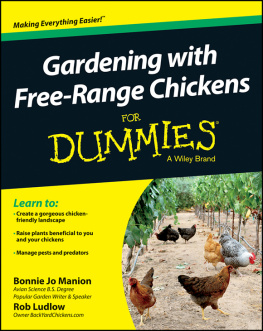FREE-RANGE
chicken gardens

FREE-RANGE
chicken gardens
How to Create a Beautiful, Chicken-Friendly Yard

Jessi Bloom
WITH PHOTOGRAPHS BY
Kate Baldwin

To my grandmother, Iva
And all who welcome chickens into their gardens

table of contents
1
chickens and gardensworking together
2
chickens in your garden practical considerations
3
designing a chickenfriendly garden
4
landscape materials for chicken gardens
5
plants with purpose
6
innovative chicken housing
7
friends and foes of hens in the garden


introduction

WHEN I FIRST GOT CHICKENS, I MADE A LOT OF MISTAKES. In the first few weeks of letting them roam freely in the garden, youd often find me chasing them around in circles, trying to get them to go where I wanted, which is about as easy as herding cats. Our first chicken coop provided adequate shelter, but ended up being better housing for rats than birds. And I wanted to collect breeds just like I collect plantsat least one of every kind, pleaseignoring my husbands warnings of becoming a chicken hoarder. Fast forward, and now our girls will come when called and even hop inside visitors cars as if they are ready to hit the town. Their housing is clean, rodent-proof, and an impenetrable barricade from night predators.
Their days are spent weeding the garden beds, mowing the lawn, and chasing insects, between regular dust baths to groom themselves and lounging in the sun. Its a great arrangement for everyone.
Chickens are easily one of the most useful animals we can have in our lives. Unlike other pets we keep, chickens provide us with foodfresh from our own backyard. For gardeners, chickens can be a resourceful tool as well as a companion, but there is much to know so the birds dont wreak havoc in your garden.
There are not many resources available for gardeners who would like to know whats involved in keeping chickens, or for chicken owners who want a beautiful garden with free-ranging hens in it. This book takes you through the basics of starting with chickens, from how many to get, to what breeds will be best for you, to acclimating them to your garden and routines. It also covers the essentials of keeping your chickens protected, even training the birds. The heart of the book has you looking at your garden as habitat for your flock, starting with the basic elements of landscape design, then selecting materials for fencing and hardscapes, onto choosing chicken-friendly plants, and reviewing sample garden designs. One chapter is devoted to innovative coop design, followed by profiles of predators and information on health care. Each dimension of the book is explored with photos and illustrations.
While doing research for the book, I interviewed gardeners with chickens from throughout the country, and I found that they all did things differently. Their gardens varied, and they faced different challenges. In each chapter, Ive included a story on a chicken keeper who has a successful system of chickens in the garden. Its my hope that this book will inspire gardeners to become chicken-keepers and create a partnership with their chickens in having a functional and beautiful outdoor space.


CHICKENS AND GARDENS
working together

With food politics currently in the media forefront and self-sufficiency becoming mainstream, victory gardens are being built again everywhere, and across the country citizens are banding together to legalize poultry in their backyards. More and more, chickens are becoming part of our gardens, providing us with fresh eggs, but their strengths as garden helpers are often overlooked.

A Rhode Island red hen walks up a garden path.


I am sitting in the garden with one of my favorite gardening buddies, an Easter Egg hen. This black hen can find shelter in the plants along the driveway if a predator flies overhead.
jessis girls

I LIVE ON A SMALL PIECE OF LAND NORTH OF SEATTLE, Washington, with my husband and two young boys, amidst lush gardens, dogs, ducks, turkeys, a goat, a horse, and about a dozen chickens who roam freely, greeting visitors and tending the gardens. The girls free range during the day and roost at night in a small barn with other animals. The roof water from the building is collected in a 300-gallon cistern and overflows into a trough, then into a small pond. Weve kept all different breeds of chickens and have offered sanctuary and a home to many rescued animals. The chickens are our pets with benefits: they provide food, fertilizer, and garden help, and they also teach my children lessons about where their food comes from and about the responsibility of caring for the birds.
Our gardens are completely organic, with a mixture of native plants, ornamentals, and edibles planted together in different beds, layers, and garden rooms. Our chickens rarely eat plants that are not meant for them to eat, and have never had damaging levels of parasites or serious disease. We have very few predator problems because of the coverage from plants, fencing, and protective animals we keep such as dogs. Weve always let our chickens free range, and we have adapted by protecting particular plants when necessary and arranging for the birds to help us with garden chores by using a chicken tractor, which is a bottomless portable pen.
The chickens offer a sense of humility and peace, which helps keep me grounded. If Im having a bad day, I only need to spend a few minutes with them before I feel good again. Their silly antics make us all laugh, and their sense of family is inspiring to watch. They have complex social lives and distinct personalities, and they really do take care of each other but still have occasional tiffs. I couldnt imagine having a garden without chickens.
Next page





















